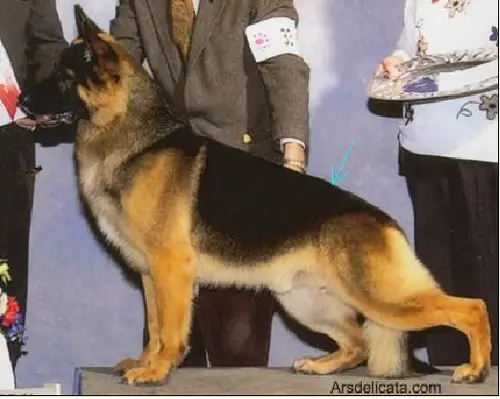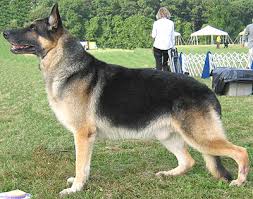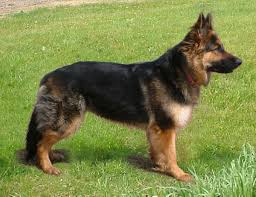
This is a placeholder text
Group text
by Ibrahim on 12 August 2013 - 12:08
.jpg)
by Ibrahim on 12 August 2013 - 12:08
I agree
This is my best guess

This is my best guess

by Dawulf on 12 August 2013 - 21:08
Thank you for posting this, Vonnisk, and thank you Ibrahim and all the others for clearing that up a bit... It is something I've wondered about too!
by Immerrecht on 17 August 2013 - 06:08
Slightly veering off subject - you have shown a) a very good diagram of exactly what constitutes a croup and b) some fairly good photographs trying to explain where it starts.
However, let me direct you to the photos on 'page 2' of this thread that immediately precede the diagrams (the first one shows a 36 degree angle). It is my understanding that the breed standard (of whichever country you care to pick) says that the topline from withers to croup should be straight (Some call the whole thing the back and some specify that it's back and loin). Can someone please explain to me how any of the three dogs in those photographs can be considered to have a straight topline? In all 3 example there can be no argument whatsoever that there is a very distinct curve between withers and croup yet I see, again and again, people claiming that dogs like this adhere to the breed standard.
I really would like someone to give me a clear explanation of how 'curved' can possibly equal 'straight'.
Thank you, in advance.
However, let me direct you to the photos on 'page 2' of this thread that immediately precede the diagrams (the first one shows a 36 degree angle). It is my understanding that the breed standard (of whichever country you care to pick) says that the topline from withers to croup should be straight (Some call the whole thing the back and some specify that it's back and loin). Can someone please explain to me how any of the three dogs in those photographs can be considered to have a straight topline? In all 3 example there can be no argument whatsoever that there is a very distinct curve between withers and croup yet I see, again and again, people claiming that dogs like this adhere to the breed standard.
I really would like someone to give me a clear explanation of how 'curved' can possibly equal 'straight'.
Thank you, in advance.
by guddu on 17 August 2013 - 10:08
Ibrahim: Thanks for the education, first time I understood (somewhat) what a croup means. Always enjoy your informative posts.
Even though, I have to steel myself before I can see SL dogs with banana backs..
Even though, I have to steel myself before I can see SL dogs with banana backs..

by Blitzen on 17 August 2013 - 10:08
Immerrecht, are you speaking of the WL's, the GSL's or the ASL? Is this a sincere question?
by Hundmutter on 17 August 2013 - 13:08
For the benefit of Immerrecht (an Alsatianist), here is what a
couple of acknowledged breed experts have to say about the
"straight back" [not straight 'topline' ]:
Nem Elliott (revised 1983 by Percy, her husband and SV Judge) -
p58-9, The Complete German Shepherd Dog.
"Back.
Here is perhaps the most controversial area of the dog,
especially if we include withers and croup, to give the
complete 'topline'. It has always been my opinion that
we cannot have a good dog, with a bad back. ...given the
correct proportions (outlined previously) and the correct
topline, we are on the way to having a good dog. These
are qualities which have a great influence on the dog's
general appearance which is of far greater importance
than details.
The back is described as the area between the withers and
the croup, and should be "straight, well developed and not too
long". ...Having campaigned for many years against the
acceptance of weak, dippy backs, it is certainly not my wish
to see a move in the opposite direction and so arrive at the
roach back....This is wrong; a dog with a slightly raised back
can be given a good place when judging, but it has to win
in spite of the back, not because of it.
...The ideal topline, as accepted by the most knowledgeable
of judges, irrespective of country, is the unbroken flowing line.
This is composed of a well defined wither, sloping into the back,
without disrupting the flowing line. Then we have the straight line
of the back, which is joined into the line of the gently curving croup,
down to the tail. (Approx. 23 degrees) - The haunch bone (ilium &
sacrum) forms the skeletal basis of the croup, but do not think that
the angle of this is 23 o, it is not - it is the visible overline of the
croup this angle refers to.
... I think that when viewing the ideal topline, ie the line of the back,
over the loin, and just before the pin bones, the line has already
started to fall very slightly. This is not a roach back but a straight
line, towards the end of which the slight fall runs into the croup, and
so excludes any possibility of protruding pin bones".
"Editor":PLEASE NOTE 'STRAIGHT', not 'level' or 'flat' !!!
Dr Malcolm Willis
p33, The German Shepherd Dog - A Genetic History of the Breed.
The back - the area between the withers and the croup - is relatively
short, suggesting that length stems from the body (prosternum to
ischial tuberosity) rather than the back. ... A long-backed animal,
especially if that back is soft, will not be able to project power from
the hind thrust through the back and it will tend to move like a dog
in two separate halves. The withers are higher than the back and
should be long and sloping so that they join the back in a flowing
line without a clearly defined break. The back should slope slightly
from front to back... Both (UK and USA) Standards are clear about
not wanting either a dippy back or a roached one. However, a 'roach'
is a clearly defined elevation in the centre of the back such that the
spine arches. This is not as common as critics suggest. A slight
arching over the loin when gaiting (*) occurs and should not be confused
with a roach back. However, given the choice, a roach back is a lesser
evil than a long soft one."
'Ed' ( * ): and when poorly stacked so that the dog is stood shortened,
enhancing the curve !
Malcolm then continues to write, of the croup:
"The croup needs to be long and gently curving. ... Certainly short or
flat croups are undesirable and would probably both lead to restricted
movement and possibly to elevated tail carriage. A long croup does
allow greater area for muscle to attach, and could thus lead to desirable
wider thighs. Croups are not easy to assess in stationary animals and
are best determined on the move. It is the animal's use of its croup
which is most important."
couple of acknowledged breed experts have to say about the
"straight back" [not straight 'topline' ]:
Nem Elliott (revised 1983 by Percy, her husband and SV Judge) -
p58-9, The Complete German Shepherd Dog.
"Back.
Here is perhaps the most controversial area of the dog,
especially if we include withers and croup, to give the
complete 'topline'. It has always been my opinion that
we cannot have a good dog, with a bad back. ...given the
correct proportions (outlined previously) and the correct
topline, we are on the way to having a good dog. These
are qualities which have a great influence on the dog's
general appearance which is of far greater importance
than details.
The back is described as the area between the withers and
the croup, and should be "straight, well developed and not too
long". ...Having campaigned for many years against the
acceptance of weak, dippy backs, it is certainly not my wish
to see a move in the opposite direction and so arrive at the
roach back....This is wrong; a dog with a slightly raised back
can be given a good place when judging, but it has to win
in spite of the back, not because of it.
...The ideal topline, as accepted by the most knowledgeable
of judges, irrespective of country, is the unbroken flowing line.
This is composed of a well defined wither, sloping into the back,
without disrupting the flowing line. Then we have the straight line
of the back, which is joined into the line of the gently curving croup,
down to the tail. (Approx. 23 degrees) - The haunch bone (ilium &
sacrum) forms the skeletal basis of the croup, but do not think that
the angle of this is 23 o, it is not - it is the visible overline of the
croup this angle refers to.
... I think that when viewing the ideal topline, ie the line of the back,
over the loin, and just before the pin bones, the line has already
started to fall very slightly. This is not a roach back but a straight
line, towards the end of which the slight fall runs into the croup, and
so excludes any possibility of protruding pin bones".
"Editor":PLEASE NOTE 'STRAIGHT', not 'level' or 'flat' !!!
Dr Malcolm Willis
p33, The German Shepherd Dog - A Genetic History of the Breed.
The back - the area between the withers and the croup - is relatively
short, suggesting that length stems from the body (prosternum to
ischial tuberosity) rather than the back. ... A long-backed animal,
especially if that back is soft, will not be able to project power from
the hind thrust through the back and it will tend to move like a dog
in two separate halves. The withers are higher than the back and
should be long and sloping so that they join the back in a flowing
line without a clearly defined break. The back should slope slightly
from front to back... Both (UK and USA) Standards are clear about
not wanting either a dippy back or a roached one. However, a 'roach'
is a clearly defined elevation in the centre of the back such that the
spine arches. This is not as common as critics suggest. A slight
arching over the loin when gaiting (*) occurs and should not be confused
with a roach back. However, given the choice, a roach back is a lesser
evil than a long soft one."
'Ed' ( * ): and when poorly stacked so that the dog is stood shortened,
enhancing the curve !
Malcolm then continues to write, of the croup:
"The croup needs to be long and gently curving. ... Certainly short or
flat croups are undesirable and would probably both lead to restricted
movement and possibly to elevated tail carriage. A long croup does
allow greater area for muscle to attach, and could thus lead to desirable
wider thighs. Croups are not easy to assess in stationary animals and
are best determined on the move. It is the animal's use of its croup
which is most important."
by Ibrahim on 17 August 2013 - 14:08
This is my own understanding of what the standard calls for in a correct back (I might be wrong)
Straight and slightly sloping. I think straight means there is no drop in the back which is indication of weakness. The word straight was used in the standard before roached backs appeared, therefore straight is not the opposite of roached.
Also it is my understanding that a correct back should not be excessively curved, if there is a slight curvature it is ok. If straight means there is no drop then most of backs are straight. Should straight mean straight as in straight line then you can hardly ever find a dog with a straight back.
It is also my understanding that croup angle is calculated from the horizontal line and not the topline. Though when standard talks about croup it relates it to the back itself,I wonder what others think of this too.
I confess that what Hundmutter quoted about the back and topline (the difference isn't very clear tome), would be nice if someone can rephrase it for me simply.
Ibrahim
Straight and slightly sloping. I think straight means there is no drop in the back which is indication of weakness. The word straight was used in the standard before roached backs appeared, therefore straight is not the opposite of roached.
Also it is my understanding that a correct back should not be excessively curved, if there is a slight curvature it is ok. If straight means there is no drop then most of backs are straight. Should straight mean straight as in straight line then you can hardly ever find a dog with a straight back.
It is also my understanding that croup angle is calculated from the horizontal line and not the topline. Though when standard talks about croup it relates it to the back itself,I wonder what others think of this too.
I confess that what Hundmutter quoted about the back and topline (the difference isn't very clear tome), would be nice if someone can rephrase it for me simply.
Ibrahim
by Ibrahim on 17 August 2013 - 14:08
"The croup needs to be long and gently curving
I know judges and breeders look for semi straight croups not curved croups,
I know judges and breeders look for semi straight croups not curved croups,
by Ibrahim on 17 August 2013 - 14:08
These are not straight backs




Contact information Disclaimer Privacy Statement Copyright Information Terms of Service Cookie policy ↑ Back to top




